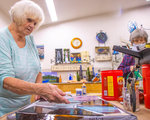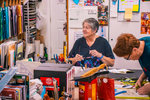








Editor’s Note:The Chronicle is working to assist local businesses suffering from the effects of the COVID-19 virus spread and associated government orders to close or limit commerce. There will be a feature on a local business in each edition of The Chronicle and at chronline.com moving forward. To be considered, email reporter Eric Trent at etrent@chronline.com. Additionally, The Chronicle will continue to offer its coverage of the coronavirus and its effects across the community, state and nation free outside of our paywall at chronline.com.
ROCHESTER — When Karen Milton walked into an art studio 40 years ago, she noticed a large, round stained-glass window on display and immediately fell in love with it. She asked the owner how much it cost. The answer was $3,000. And how much did it cost to make — $300.
“I’m thinking, ‘I need to be in this business because I would be rich,’” Milton said. “Doesn’t happen that way. So much time and work into it.”
So Milton jumped head-first into stained-glass artwork and has been at it ever since. Though she never got rich off it, she still loves creating new pieces and teaching others how to build their own.
After selling her work privately and taking commissions, she began teaching classes in 1983. When she broke her ankle and could no longer work a normal job, her husband suggested she just open her workshop to the public. So 12 years ago, Milton opened Karen’s Stained Glass and has been going strong ever since.
When she opened her workshop to the public, she began stockpiling supplies and her shop is now filled to the brim, wall-to-wall with both her completed works and various supplies. There is colored glass, grinders, pattern paper, soldering irons, glass cutters and many other materials. A separate room in the back is the kiln room, which holds four kilns, all of varying sizes.
She can hold classes of up to eight people at a time currently. Her classes run Tuesday, Wednesday, Thursday from 10 a.m. to 3 p.m. Tuesday night from 5:30 p.m. to 8:30 p.m. Thursday night from 6 p.m. to 9 p.m. She does hold infrequent Monday classes but not many on Fridays or Saturdays.
Nearly all of her upcoming classes are booked at the moment. Thursday nights are the only ones she has openings for at this time. Some of her pupils have been coming to her classes for up to 10 years. She even teaches evening classes through Centralia College, a program she’s run for 13 years now, where students visit her workshops and learn the basics of creating stained-glass artwork.
“I called them and said, ‘Somebody told me you’re looking for a stained-glass teacher?’” Milton said. “They didn’t even come out and ask me qualifications or anything. They said, ‘Sure. We’ll start signing up people.’ It’s fun. I get a lot of people from the college.”
Milton certainly did have the qualifications. She worked at a stained-glass studio in Tacoma for over 18 years, creating all the commissioned work for the business. She also taught classes up there, even at Joint Base Lewis-McChord, working six days a week for the studio and teaching classes three of those nights.
The first type she begins teaching newcomers is leaded stained-glass panels. She has over 100 patterns for people to choose from. Lead allows for the ability to hide little mistakes, as opposed to copper foil, another popular method. After students have completed a lead project, they can either do lead again to perfect the craft or jump to foil or fusing.
Milton used to bring her artwork to shows and sell them. Now she’s gotten too busy and doesn’t really have an avenue to sell them. She still does commission work and a lot of repairs. Some pieces on display in her workshop are for sale, noted by a price tag, and anything without one is used for demonstrations.
A timeframe to construct a piece varies wildly and depends on a lot of factors. If a customer came in and had a pattern copied out of a book and asked to have it built, she could have it ready pretty quickly. If she has to come up with the design on her own, there’s the back and forth or checking with the customer to see if it’s what they are wanting, and could take some time.
“It can take anywhere from a month to months to do a decent piece,” Milton said.
What keeps her going after four decades of honing her craft is the variety and newness each project offers. No two pieces she creates are ever the same.
“I wouldn’t like any job where I was doing the same thing or cutting the same pattern every time,” Milton said. “And I like that my students challenge me. They’re always saying, ‘Did you see this new tool?’ And some of them get better than me. They get to where they know almost everything I know.”
•••
Reporter Eric Trent can be reached at etrent@chronline.com. Visit chronline.com/business for more coverage of local businesses.